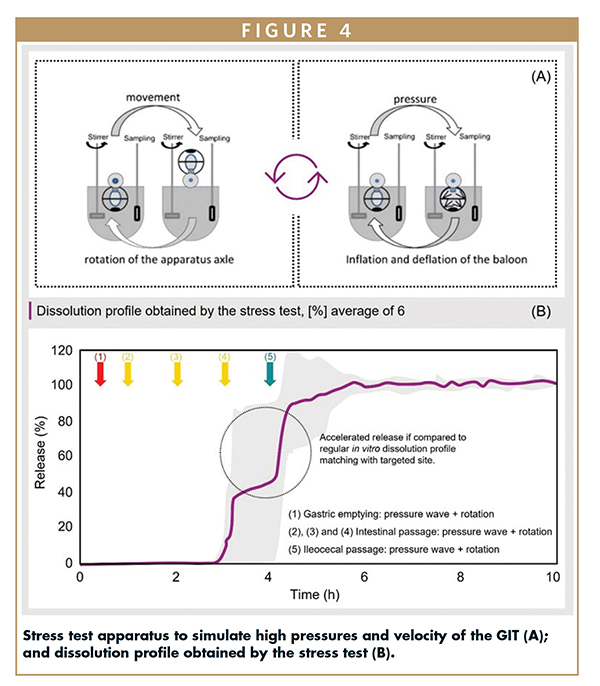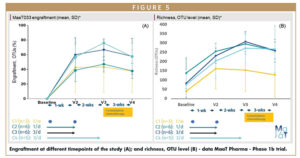Issue:March 2024
DRUG DELIVERY - EUDRACAP® Select - Examining a Case From Development to Clinical Trial
INTRODUCTION
Formulating live biotherapeutics and accelerating drug development time can be challenging. The following study focuses on the development of a customized functional coated capsule, EUDRACAP® Select, for the delivery of live biotherapeutics and demonstrates its effectiveness in the oral delivery of a sensitive proprietary microbiome ecosystem while simplifying the drug development process.
Growing scientific evidence strongly suggests the microbiome plays a crucial role in various diseases, impacting everything from immune function and inflammation to metabolism and mental health. Understanding these implications could lead to groundbreaking advancements in disease prevention, diagnosis, and treatment. Certain diseases or medical treatments can disrupt the microbiota, leading to an imbalance known as dysbiosis. Restoring the complete gut microbiota ecosystem is a promising therapeutic tool to improve clinical outcomes in patients.
Cancer and its treatments can disrupt the gut microbiota, impair gut epithelial repair mechanisms, and compromise immune homeostasis and responsiveness. Microbiome therapy can prevent the decay of the gut ecosystem, preserve immune homeostasis, and optimize gut function. To achieve the desired clinical outcome, a robust and targeted delivery system is crucial.
Microorganisms are normally sensitive to acidic conditions and therefore require an acid-resistant delivery system. At the same time, they should not be exposed to the high moisture and temperatures of standard enteric coating processes, which could lead to a reduction in the number of viable microorganisms. The use of a customized, empty, ready-to-fill, modified-release coated capsule is a viable alternative for this type of therapy.
The study discussed here focuses on an oral formulation developed in a collaboration between Evonik and MaaT Pharma, with Evonik providing functional ready-to-fill EUDRACAP Select capsules and MaaT Pharma providing stable, pooled, full ecosystem microbiota.
OBJECTIVE & SOLUTION: DEVELOPING A SUITABLE ORAL DELIVERY SYSTEM
The objective of this study was to develop a suitable oral delivery system for the full ecosystem fecal microbiota and test its safety and tolerability in acute myeloid leukemia (AML) patients exposed to intensive rounds of chemotherapy and antibiotics in a Phase 1b clinical trial sponsored by MaaT Pharma (identifier NCT04150393). EUDRACAP Select functional capsules were developed to address the above challenges.
DEVELOPMENT OF CUSTOMIZED EUDRACAP SELECT CAPSULES
Pre-locked, hard HPMC capsules were used for this study. Empty capsules were coated with a proprietary combination of EUDRAGIT® polymers to a specific weight gain based on their surface area. These ready-to-fill, enteric capsules were compatible with standard filling equipment and required no banding or additional downstream processing.
Coating performance was evaluated via a three-stage dissolution test. Caffeine:lactose blends were filled into enteric-coated size 0 capsules. Dissolution tests were performed in USP Type II apparatus at 37°C, with a basket speed of 75 rpm; filled capsules were exposed to 0.1 N HCl media for 2 hours followed by pH 6.8 potassium phosphate monobasic buffer for 1 hour and pH 7.2 buffer for 2 hours. The developed capsules were also subjected to a biorelevant dissolution test described further.
For the Phase 1b clinical study, the capsules developed were filled with a specific amount of MaaT’s proprietary standardized, high-richness, high-diverse microbiome ecosystem, containing a group of bacterial species, the Butycore®, known to produce anti-inflammatory short-chain-fatty acids. The study was performed according to the protocol described further (identifier of the study: NCT04150393).
For illustrative purposes, Figure 1 shows capsules coated in the pre-locked (1), opened (2), and locked (3) stages; these capsules were produced by a process similar to that described here. Part of the capsule body is not coated as shown in Figure 1. This part of the body is fully covered when the capsule is in the final locked stage, as observed in Figure 1. In the final locked stage, the cap also covers part of the coated area of the body, this helps to form a hermetic seal between the cap and the body of the capsule.

PROTOTYPES MATCHING THE TARGETED PROFILE
During the development phase, different formulations and weight gains were tested to target the lower end of the gut. The targeted release is expected to occur at the ileocecal junction. For this purpose, three prototypes were tested to find the optimal amount of coating and combination of polymers. Figure 2 shows Prototype 1 is not robust enough and has a considerable level of standard deviation. On the other hand, Prototype 3, despite being more robust, delays the release tested in vitro. This behavior could indicate the amount of polymer applied to the capsule is higher than necessary and could possibly delay the release in vivo. Therefore, Prototypes 1 and 3 were not considered for further steps. Prototype 2 showed full protection in HCl 0.1 M up to 120 min and also for a further 60 minutes in pH 6.8, after which its contents were rapidly released in pH 7.2. Therefore, Prototype 2 was selected as the most promising formulation and was then submitted for a stability study.

EMPTY CAPSULES TESTED FOR STABILITY
To test the stability of the capsules, a stability program was established with four different conditions: (a) long-term, (b) intermediate, (c) accelerated, and (d) long- term in refrigerated conditions. The latter was included in the stability study program to ensure lower temperatures would not cause the capsule to become brittle at some point in time, which could be a risk factor for the final product formulation. The capsules included in the stability study were sampled from a representative scaled-up technical batch. The capsules were stable under all the different conditions tested, including accelerated and refrigerated. Considering the higher importance for this project, in which the final pooled full ecosystem microbiota needs to be stored under refrigerated conditions, only the results of this condition are shown in Figure 3. The 6-month stability study carried out so far has yielded positive results for all conditions tested, ensuring a robust functionally coated capsule has been achieved. The long-term stability study is still ongoing.

IN VITRO PREDICTION OF CAPSULE BEHAVIOR & ROBUSTNESS
The cost of clinical trials in drug development has been increasing in recent years and has a significant influence on the overall development costs. Therefore, it is advisable to stress the developed drug as much as possible in in vitro tests to reduce the risk of failure in later clinical studies. Dissolution of modified-release products can be significantly influenced by physical stress of biorelevant magnitude in the human GI tract, such as high pressure, low buffering capacity, and jet-like propulsions, and this is not easy to predict by in vitro studies.1
To simulate the physicochemical conditions of the GI tract, the EUDRACAP Select capsules were subjected to a dissolution stress test performed by a specific device capable of simulating the levels of physiological mechanical stresses that occur during the passage of a solid dosage form through the GI tract. The dosage form is subjected to sequences of agitation, including movement and pressure fluctuations, alternating with static phases, as observed in vivo. The device also allows simulation of intermittent contact of the dosage form with the dissolution medium. In addition, the intestinal pH profiles, characteristic of fasting intake conditions, were simulated with a biorelevant medium.
Figure 4 shows a schematic of the test set-up. Movements and pressures are applied according to a defined protocol as detailed in Figure 4 (B), which also shows there is no release of capsule contents for up to 2 hours. During simulated gastric emptying (1), the capsules yielded no deformation and signs of leakage. Low- intensity mechanical stress simulated at 1 hour (2) and 2 hours (3) did not affect drug release. The mechanical agitation simulated at 3 hours (4) triggered fast dissolution of part of the tested capsules. Ileocecal passage at 4 hours (5) triggered fast drug release (deformation and perforation) from the capsules.
The results indicate Prototype 2 capsules are capable of delivering live biotherapeutics to the distal small intestine and proximal colon, making them suitable for first-in-human trials.

ENCAPSULATED FULL-ECOSYSTEM MICROBIOTA WAS TESTED IN PHASE 1B CLINICAL TRIAL
AML treatment combines intensive chemotherapy (IC) with broad-spectrum antibiotics (ATB) that induces a strong gut microbiota dysbiosis, promoting pathological conditions and increasing incidence of complications. Growing evidence suggests loss of diversity in the gut microbiota due to conditioning regimen, chemotherapy, antibiotics, and reduced dietary intake promotes the development of Graft-versus-Host disease (GvHD) and impact negatively overall survival of patients receiving allogenic hematopoietic stem cell transplantation.2
The developed EUDRACAP Select capsule containing lyophilized pooled full ecosystem fecal microbiota drug candidate (MaaT033) was tested for tolerability, safety, and efficacy in a Phase 1b clinical trial. The study was an open-label, single-arm with 21 patients divided into 5 different cohorts. This study, sponsored by MaaT Pharma, took place at six investigational sites in France. The dose was scaled and administered according to Table 1. The objectives of the study were to test tolerability, dose regimen (safety and activity, engraftment), and patient compliance, and to select the dose for Phase 2 study.

Cohort 5 was not performed because sufficient data were obtained from cohorts 1 to 4. Engraftment and richness in operational taxonomic units were examined on day 0 (baseline) of the treatment, and then on days 7 (±2) (V2), 19 (±5) (V3), and 44 (±10) (V4).
STRONG ENGRAFTMENT & INCREASED MICROBIOTA RICHNESS OBSERVED
The results of the Phase 1b clinical trial were first reported at the 64th edition of the American Society of Hematology.3 Figure 5 (A) shows strong and sustained engraftment was observed in all four cohorts, even stronger for cohort 3 and cohort 4, in which three capsules per day were administered. The engraftment level refers to the ratio of operational taxonomic units (OTU) that were not present in the patient at baseline, but were present in MaaT033 and were found in the patient following treatment, ie, the treatment-induced related engraftment. For this analysis, shared OTUs between MaaT033 and patients at baseline were excluded (values starting from zero). Persistent engraftment can be observed by relatively stable OTU levels at V4, following consolidation of chemotherapy and about 4 weeks following the treatment with MaaT033 was finished. It was also observed MaaT033 bacterial engraftment is inversely correlated with patients’ baseline microbiota richness (data not shown).
The richness of the microbiota was also evaluated in terms of variety of engrafted OTUs. Similar to the engraftment results, an increase in the number of OTUs was induced by MaaT033, which was also persistent, especially for cohort 2, cohort 3, and cohort 4, as shown in Figure 5 (B).
During the study, four serious adverse events were reported in four patients, but only one was considered as possibly related by the investigator. This event was an infectious diarrhea with enteropathogenic E. coli that started 3 days following MaaT033 treatment initiation. Genome sequencing was performed, and it was concluded the E. coli that caused the reported event was not found in the MaaT033 or in the patient before the treatment started, so although the association between the event and MaaT033 is highly unlikely, it cannot be formally excluded. Other events were not reported as serious or potentially related to MaaT033.
CONCLUSION
In vitro testing has demonstrated the efficacy of the developed EUDRACAP Select used in the MaaT033 formulation, even under stressful conditions. MaaT033 formulated with EUDRACAP Select appears to be safe and effective in restoring gut microbiota in AML patients receiving IC and ATB. Three MaaT033 capsules per day for 1 week induce an increase in microbiota richness and an effective and persistent engraftment in AML patients. A Phase 2b trial is underway to evaluate MaaT033 as an adjunctive in patients with hematological malignancies receiving allogeneic hematopoietic stem cell transplantation.
Evonik has provided a capsule that is effective and robust enough to deliver even sensitive molecules. The capsule is ideal for powders, pellets, granules, and other dosage forms and is compatible with high-speed capsule filling machines. Using EUDRACAP capsules saves developers time in process scale-up and validation, and has the benefit of using EUDRAGIT polymers, which have been around for 70 years.
REFERENCES
- G. Garbacz, S. Klein, Dissolution testing of oral modified-release dosage forms, J Pharm Pharmacol, 64 (2012) 944-968. Peled, J.U. et al. Microbiota as Predictor of Mortality in Alloceneic Hematopoietic-Cell Transplantation. N Engl J Med 382, 822-34 (2020). doi: 10.1056/NEJMoa1900623.
- Ghani R et al, Disease Prevention Not Decolonization: A Model for Fecal Microbiota Transplantation in Patients Colonized With Multidrug-resistant Organisms. Clin Infect Dis. 2021 Apr 26;72(8):1444-1447 doi: 10.1093/cid/ciaa948.
- Jenq RR. et al, Intestinal Blautia Is Associated with Reduced Death from Graft-versus-Host Disease Biol Blood Marrow Transplant 2015 Aug 21(8): 1373-1383 doi: 10.1016/j.bbmt.2015.04.016.

Lucas Cusin is a pharmacist with more than 10 years of experience in the field of oral excipients. He currently works at Evonik as a Strategic Project Manager, with a focus on oral drug delivery.

Dr. Steven Smith earned his PhD in Chemistry for his research on covalent and covalent-reversible kinase inhibitors and currently works at Evonik as Head of Customer Projects focusing on formulation development for oral dosage forms.

Dr. Kamlesh Oza earned his PhD from The Ohio State University and at Evonik, heads Technical & Formulations and Application Services for North America.
Total Page Views: 4423












